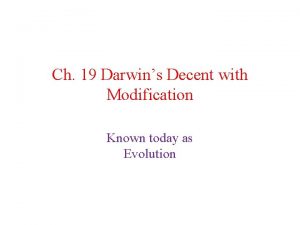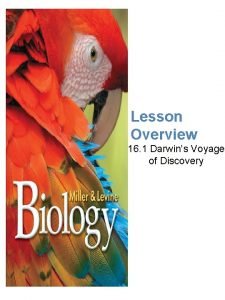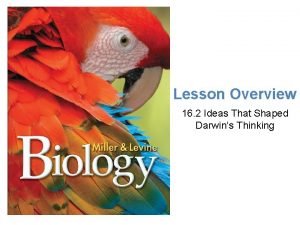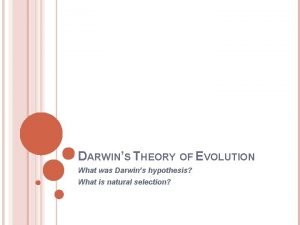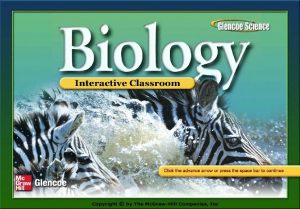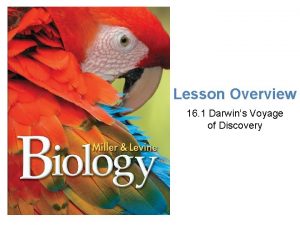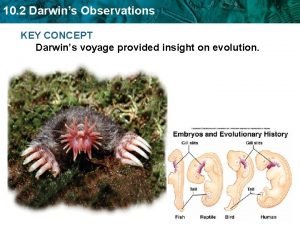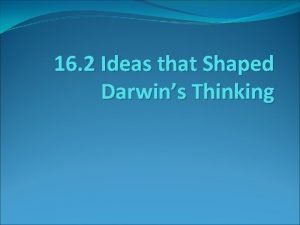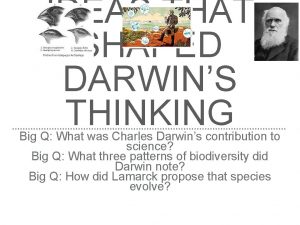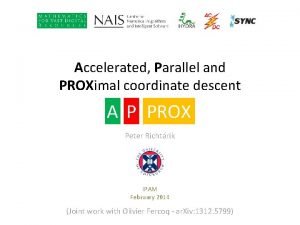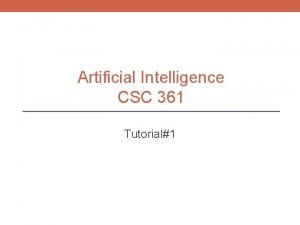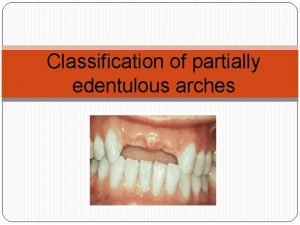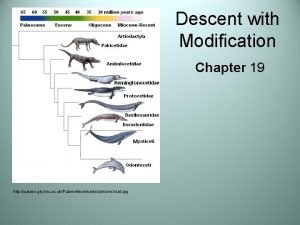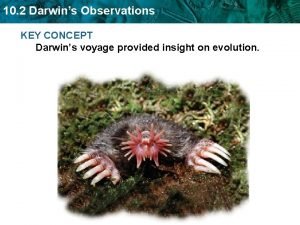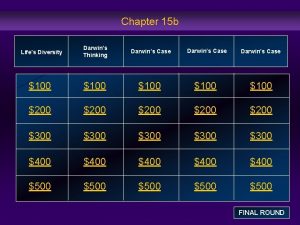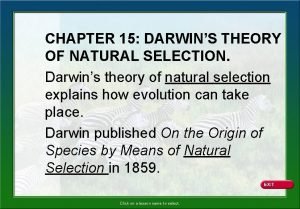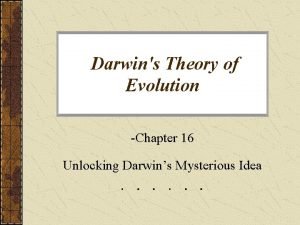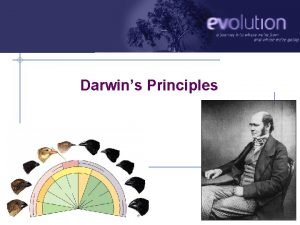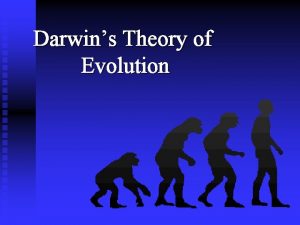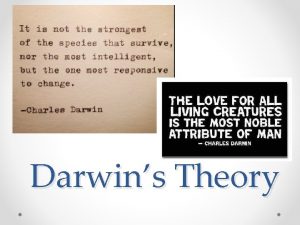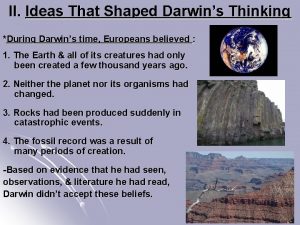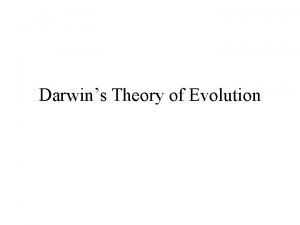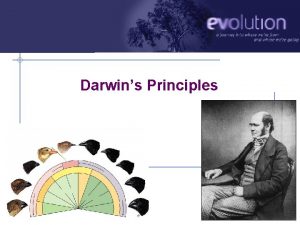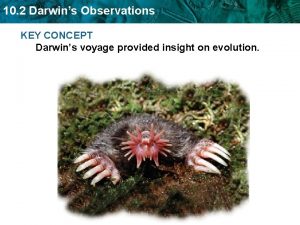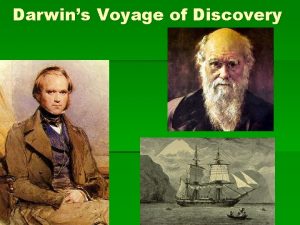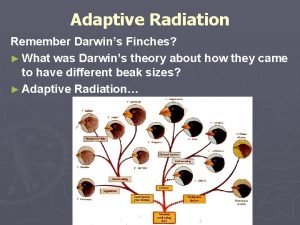Ch 19 Darwins Decent with Modification Known today






























- Slides: 30

Ch. 19 Darwin’s Decent with Modification Known today as Evolution

2 Key Points of Natural Selection # 1 NS is a editing process …. not a creative one.

2 Key Points of Natural Selection #2 NS depends on time a place

Evidence of Evolution 1. Direct Observations 2. The Fossil Record 3. Biogeography 4. Homology

1. Direct Observations • Insect population can rapidly become resistant to pesticides such as DDT. • Evolution of drug-resistant viruses and antibiotic bacteria.

2. The Fossil Record • Fossils provide evidence for evolution. • Fossils are remains or traces of organisms from the past. They are found in sedimentary rock. • Paleontology is the study of fossils. • Fossils show evolutionary changes have occurred over time and the origin of major or major new groups of organisms

# 3 Biogeography: The geographic distribution of species • Species in a discrete geographic area tend to be more closely related to each other than to species in distant geographic areas.

Example • In South America, desert animals are more closely related to local animals in other habitats than to the desert animals of Asia. • This reflects evolution, not creation

Pangea

# 3 Biogeography: • Continental Drift and the break-up of Pangea can explain the similarity of species on continents that are distant today. • Endemic Species are found at a certain geographic location and nowhere else.

Ex. Marine iguanas are endemic to the Galapagos

# 3 Biogeography: • Darwin’s theory of evolution through natural selection explains the succession of forms in the fossils record. Transitional fossils have been found that link ancient organism to modern species , just a Darwin’s theory predicts

# 4 Homology: Characteristics in related species can have an underlying similarity even though they have different functions. • Homologous structures • Embryonic homologies • Vestigial organs • Molecular homologies

Homologous Structures • Forelimbs of mammals that are now used for a variety of purposes, such as flying in bats or swimming in whales. • Outwardly different yet same internal structure. • Shows common ancestry

Homologous Structures are anatomical signs of evolution

Embryonic Homologies • Comparison of early stages of animal development reveals many anatomical homologies in embryos that are not visible in the adult organisms. • Ex. All vertebrate embryos have a post anal tail and pharyngeal pouches

Embryonic Homologies aka comparative embryology

Vestigial Organs • Are structures of marginal, if any importance to the organism. • They are remnants of structures that served important functions in the organisms ancestors.

Vestigial Structures The Human Appendix

Vestigial Structures hind legs in whales and snakes

plica semilunaria remnant of a 3 rd eyelid (aka nicitating membrane)

Nictitating membrane in owls

Molecular Homologies • Are shared characteristics on the molecular level • Ex. All life-forms use the same genetic language of DNA and RNA. Amino Acid sequences coding for hemoglobin in primate species shows great similarity, thus indicating a common ancestor.

In a comparision of chimpanzee and human genomes

Convergent Evolution • Explains why distantly related species can resemble one another. • Convergent evolution has taken place when two organisms developed similarities as the adapted to similar environmental challengesnot because the evolved from a common ancestor.

Convergent Evolution • The likenesses that result from convergent evolution are considered analogous. • Similar problem, similar solution

Analogous Structures torpedo shapes of a penguin, dolphin and shark

What does that mean for Jupiter’s moon Europa?

Organize your thoughts 1. Evolution is change in species over time. 2. There is overproduction of offspring which leads to competition for resources. 3. Heritable variations exists with in a population. 4. These variations can result in differential reproductive success. 5. Over generations, this can result in changes in the genetic composition of the population

And Remember…. . • Individuals DO NOT evolve! Populations Evolve.
 Decent with modification
Decent with modification Lesson 1 a voyage of discovery
Lesson 1 a voyage of discovery Chapter 17 darwin's theory of evolution
Chapter 17 darwin's theory of evolution Ideas that shaped darwins thinking
Ideas that shaped darwins thinking What was darwins theory
What was darwins theory Chapter 15 section 1 darwins theory of natural selection
Chapter 15 section 1 darwins theory of natural selection Species vary locally
Species vary locally Darwins observations
Darwins observations 15-2 ideas that shaped darwin's thinking
15-2 ideas that shaped darwin's thinking Ideas that shaped darwins thinking
Ideas that shaped darwins thinking Hyphotheses
Hyphotheses Adaptation
Adaptation In todays lesson
In todays lesson Characteristic of fingerprint
Characteristic of fingerprint Today meeting or today's meeting
Today meeting or today's meeting Today's lesson or today lesson
Today's lesson or today lesson Today meeting or today's meeting
Today meeting or today's meeting Today's lesson or today lesson
Today's lesson or today lesson Coordinate
Coordinate Decent hospital
Decent hospital Ilo decent work agenda
Ilo decent work agenda Coordinate decent
Coordinate decent Decent manners
Decent manners Examine the ai literature to discover whether the following
Examine the ai literature to discover whether the following Steepest decent
Steepest decent Confounding vs effect modification
Confounding vs effect modification Parts of a typical flowering plant
Parts of a typical flowering plant Interception threat
Interception threat Kennedy classification class 6
Kennedy classification class 6 Effect modification vs confounding
Effect modification vs confounding Ameoba
Ameoba
